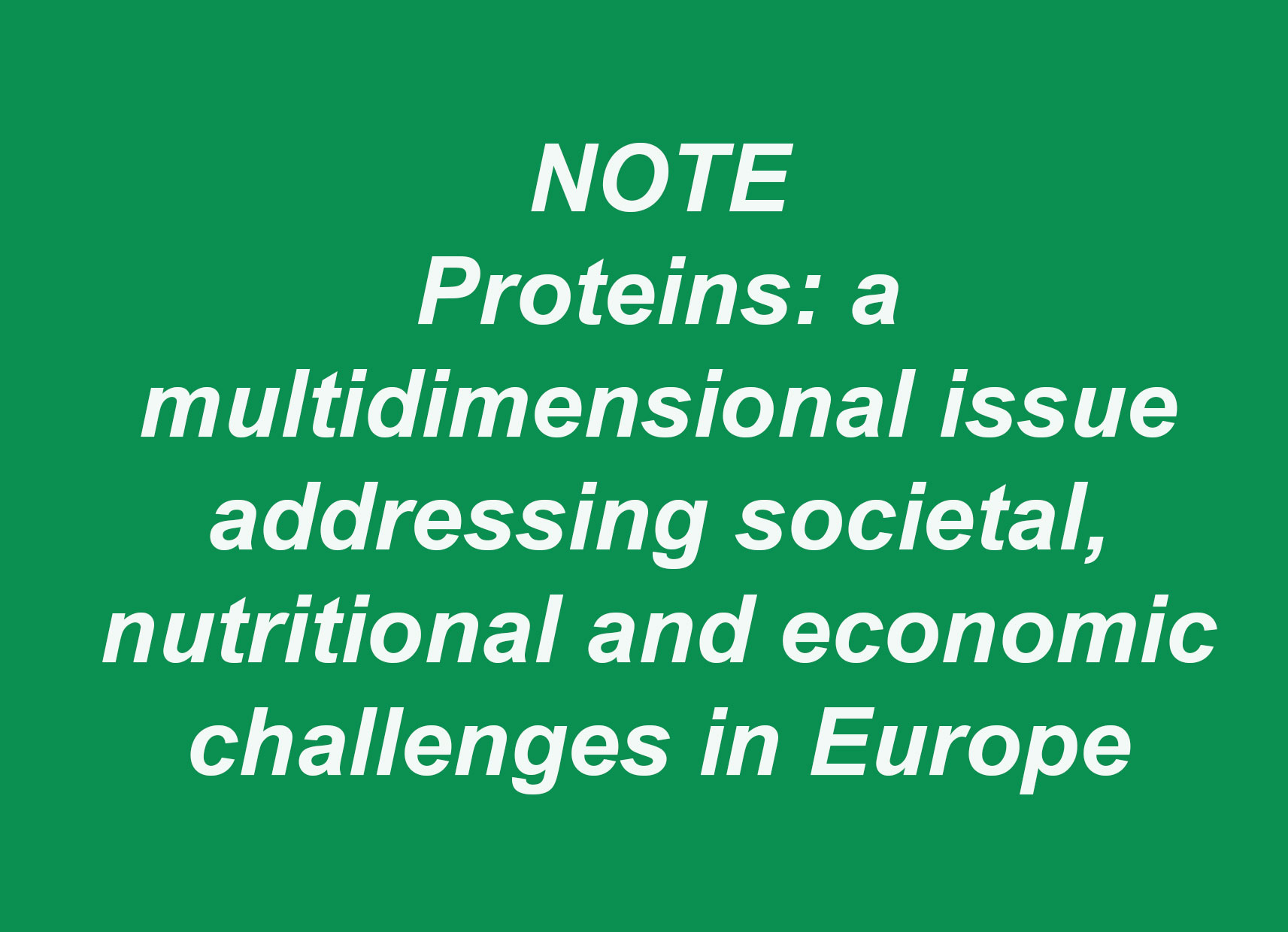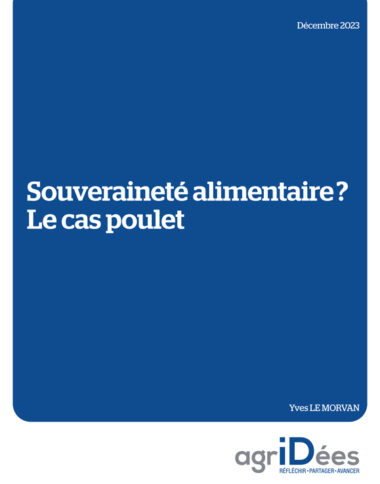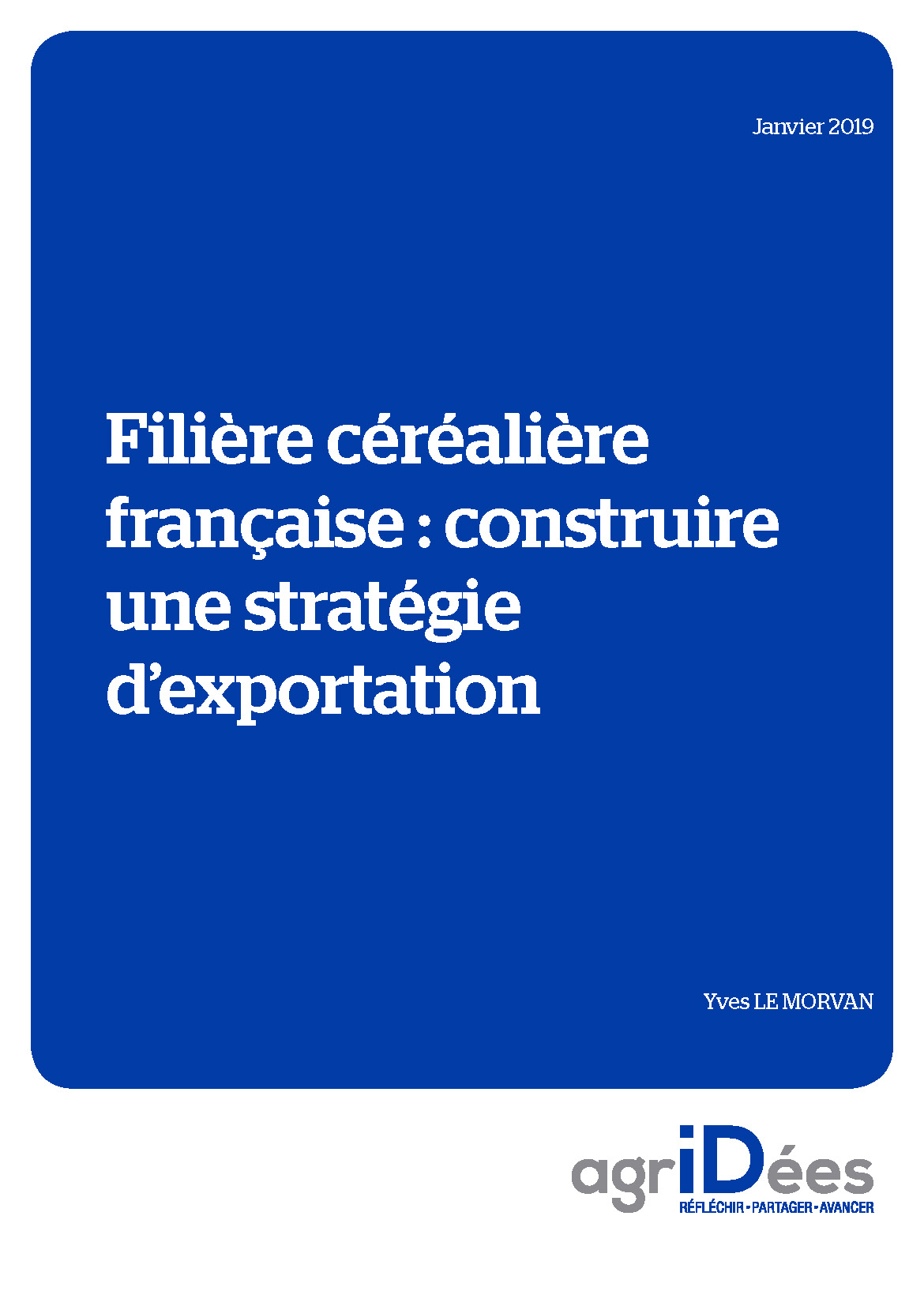Notes
Temps de lecture : 10 min
08/01/2019
Proteins: a multidimensional issue addressing societal, nutritional and economic challenges in Europe

The European Commission published a “Report on the development of plant proteins in the European Union” on November 22, 2018, following the European Parliament resolution of 17 April 17 2018 on a “European strategy for the promotion of protein crops – encouraging the production of protein and leguminous plants in the European agriculture sector.” This matter will be part of the discussions preparing the Common Agricultural Policy of 2021-2027 including a new “Protein Plan.”
Résumé
In this context, the think tank agridées published a position paper on January 8, 2019, based on the work of its working group and on the conference (agridébat) of November 13, 2018.
European authorities and stakeholders are working on the protein dossier in animal feed and the European Commission published a “Report on the development of plant proteins in the European Union” on November 22, 2018. This matter will be part of the discussions preparing the Common Agricultural Policy of 2021-2027. Regrettably, to date, the European Commission has not launched specific action, has only reviewed the current state of play and listed the tools available to Member States to develop protein production. For its part, agridées has established an ad hoc working group, whose main conclusions are presented below. They attempt to identify the challenges, for human needs as well as animal feed, and provide food for thought.
Multiple challenges
Societal expectations
Consumers are increasingly looking for food that makes sense and is of good quality. Protein content and origin are part of it. Nowadays proteins are not only a health and nutritional issue, they are also a societal issue, as citizen-consumers wonder about the impact of protein production on the environment, and the contribution of animals and plants to meet their demands.
Food that covers the needs in terms of quantity and quality is a major contributor of human well-being and animal welfare. For the World Health Organization (WHO), “Good nutrition is essential for survival, physical growth, mental development, performance, productivity, health and well-being across the entire life-span.” For the World Organisation for Animal Health (OIE – Office International des Epizooties), “freedom from hunger, malnutrition and thirst” is one of the animal’s primary welfare needs.
Non-GMO and organic demands are expanding in France and Europe. The supply chain has developed several initiatives to meet this demand in the past two decades, usually by way of quality labels (organic agriculture, labels, protected geographical indications). Non-GMOs currently account for 25 percent of compound feed produced in France, including 300 000 tons of organic feed. These initiatives have increased production costs and impacted retail prices, both in France and the EU.
In the minds of consumers, there is a confusion between sustainability and non-GMO. However, the former and the latter are not necessarily connected. Globally, there are numerous sustainability certifications for agricultural commodities that may or may not include a non-GMO criterion. A number of certified sustainable soybean production schemes have been put in place. To clarify this, the European Feed Manufacturers’ Federation (FEFAC) has published guidelines on responsible soybean supply to the EU. Certification schemes are based on them.
Nutritional needs
Proteins are indispensable to organisms, in which where they play a structural part, are involved in many mechanisms (immune response, oxygen transportation, digestion…) and are the only source of nitrogen. Protein supply in food is therefore vital for humans, as it is in feed for animals, and it must match the needs of each species, for each age and gender, in quantity and in quality.
Among the amino acids that constitute proteins, some cannot be synthesized by the human body and therefore have to be supplied by food. These are called “indispensable” amino acids. The quality of proteins in food is defined by their ability to cover the needs in indispensable amino acids of the organism (composition, availability), and by their digestibility (negatively affected by the presence of anti-nutritional factors).
In France, per capita consumption amounts to 1.4g proteins per kg of body mass per day, which is higher than nutritional recommendations (0.8 g/kg/day). Animal origins currently account for 70 percent of protein supply in food, and there is a rebalancing trend using plant-based proteins. Nevertheless, completely eliminating animal proteins can lead to deficiencies, especially among the youngest (growing children) and the elderly (with reduced assimilation). Among adults, the absence of animal-based food leads to iron deficiency. Animal proteins have a higher content in indispensable, more easily digestible amino acids, and there are less anti-nutritional factors in animal sources than in plant sources.
As is the case of humans, good quality amino acids have to be included in farmed animal feed to ensure their good health. This is necessary to ensure the quality of proteins in the meat, milk and eggs that are produced for human consumption.
Feed compounders prepare tailored feed that is adapted to the needs of each animal species, age, gender, according to the specifications of each market segment, on a daily basis. Ultimately, the composition of feed rations is way more precise and effective than that of human food, thanks to the calculations of formulators. Soybean meal is the iconic example of a product used in animal feed that naturally has a high protein content. It is one of the commodities that combine the highest protein content (48 percent) and the best quality proteins for feeding animals: its amino acid profile is extremely interesting as it is lysine-rich (an indispensable amino acid) and highly digestible. Contrary to some preconceived ideas, the nutritional properties of soybean-supplied proteins are not dependent on their GMO or non-GMO status.
The economic imperative
As animal-based proteins are beneficial to human health, meat, dairy and egg products must be accessible to consumers at reasonable prices. The European livestock and poultry industry must be competitive and meet consumer expectations in order to supply most of the European market. Feed cost is one of the leading costs of production in animal farming. The quality-cost ratio must therefore be optimised to ensure that feeds meet animal nutritional demand without harming the competitiveness of animal farming and the European livestock and poultry industry. The calculation of optimal rations is significantly subject to the price fluctuations of commodities that go into the rations. This is why animal feed compounders and farmers constantly adapt the composition of animal feed.
Apart from soybeans, which get most of the attention, several categories of resources are mobilised in Europe to meet the nutritional needs of farmed animals. The deficit in plant-based proteins fed to farmed animals is often seen as a weakness in terms of trade and strategy. In fact, the data reported are often incomplete as they focus on oilseeds and omit forages.
In France, animal breeding consumes 110 million tons of dry matter per year for feed, including 71 percent forages, 13 percent commodities as such (including self-consumption), and 16 percent industrial compound feed. In 2017, compound feed production in France amounted to 20.6 million tons, including 8.5 for poultry, 5 for swine, 5 for cattle and 2 for other species. French feed compounders cover the protein needs in the rations that they make with cereals (24 percent), cereal by-products (12 percent), and oilseed meals (57 percent). Most of the meals are soybean meals (54 percent), followed by rapeseed meal (26 percent), and sunflower meal (20 percent).
In the EU, 45 million tons of proteins are used to feed farmed animals every year, distributed into 264 million tons of commodities used as such by farmers and in compound feed. They are supplied by cereals (38 percent) and oilseed meals (45 percent), including two thirds of soybean meal. There is no estimate of the contribution of forages to the protein balance. The statistical data published annually in the European Commission Observatory must be completed with grassland contribution and broken down by species, in protein equivalent.
While the EU produces almost 3 million tons of soybeans, it imports 30 to 35 million tons of soybeans and soybean meals per year. In France, 3.5 million tons of soybeans are imported annually. These imports cannot entirely be substituted with European production, for agronomic, economic, and nutritional reasons. This situation has to be seen in relations to the demand of consumer markets: feeding animals without GMOs has a cost (the non-GMO soybean premium ranges from 5 to 80 euros per ton). This represents up to 20 percent of soybean prices and weighs heavily on the cost of compound feed with a high content in soybean meal.
Nos propositions
Food for thought
More transparency and communication are needed
Humans and animals’ nutritional needs for proteins are a reality. A balanced consumption is necessary to health and quality life. Thus, in line with agridées’ recommendation for a healthy and responsible food, information and education initiatives must be developed so that every one of us, and especially those in the farming business, become aware of the realities of the quantitative and qualitative needs in protein supply for living beings. The words of scientists and medical professionals are currently drown out by statements and postures questioning any animal-based protein for human food, and any feed containing genetically modified organisms…
In schools, specific focus could be placed on our needs for a variety of proteins in food. In addition, a European communication campaign on proteins and their uses would be welcome, both to demystify some preconceived ideas on animal breeding, and to build awareness about humans’ life quality. Beyond information and communication, stakeholders must strive towards greater transparency to improve knowledge about the conditions required from and imposed on farmers and breeders, but also to highlight and value the societal objectives of research and innovation actions, especially as these actions often receive a combination of public and private funding. Many behaviours and much of today’s ignorance can be explained by the lack of transparency on this issue.
Finally, regulation and legislation must continually evolve to take into account progress in science and innovation, combined with updated information. In their own interest, stakeholders could value the modern definition of sustainability, including societal, economic and environmental requirements. For example, certification instruments for the sustainability of agricultural commodities have little visibility among consumers. Perhaps some simple and synthetic labelling of animal products indicating the sustainability of their feed could be put in place. This labelling could become a trusted reference, as is the case for Duralim, a collaborative platform that brings together stakeholders of the food chain around clearly defined specifications.
Increasing our independence
One must recognise that the CAP has developed numerous instruments to maintain grassland areas. However, this has been done in a rather coercive way: agridées recommends to change this approach and develop incentives to produce forage. Do we need to remind ourselves that forage is the leading source of proteins for feeding livestock? Then why not include recoupled payments for grassland areas in the second pillar of the CAP, especially in lowland and simple less-favoured areas?
Another objective is to increase the share of legumes in human food and animal feed. In human food, reduced animal-sourced proteins require the supplementation of cereals (wheat, rice, maize…) with legumes (peas, beans, lentils…) in order to cover the nutritional needs for indispensable amino acids. In fact, legumes production and consumption in France and the UE are not sufficient.
In animal feed, one can consider producing new varieties of legumes to meet animal needs, and farmers’ expectations in terms of yields and overall security of their business. It would contribute to farmers’ and breeders’ competitiveness (stable high yields, simple crop management) with the diversification of protein supply for animals.
Similarly, in the European Union, policies in favour of developing biofuels based on vegetable oil has led to increased oilseed production, and rapeseed in particular. The driver of this was the oil content of the seeds, but demand priorities have changed in favour of protein content: policies have become less in favour of first-generation biofuels. Protein content must become the leading quality criterion for rapeseed. For legumes and rapeseed, plant breeding is an imperative for the future. Research on rapeseed genetics must focus on high protein contents. Producer prices should be driven by protein content rather than oil content. Rapeseed oil would therefore become the by-product of rapeseed meal rather than the contrary.
For legumes, funding plant breeding in order to create the new varieties that farmers and breeders need is essential. A “protein plan” in the first pillar of the CAP, including subsidiarity and based on recoupling, is showing its limitations. We would rather need to tackle funding and support to research, which is a second pillar action, with tenders and public-private partnerships. Procolza, Promaïs and Promosol are examples of such models. The lack of strategy by the European Commission on this point, and limiting the potential development of legume production to their inclusion in national Strategic Plans does not seem satisfactory: it reveals a lack of willingness at the European level, and is not really a game changer from the current situation.
In the medium term, the issues of animal by-products and insects will need to be addressed. Since the mad cow crisis, very few animal by-products have been allowed in animal feed. To date, the petfood industry is the leading end-user for these products. As a bioeconomy-based approach and in full compliance with the sanitary regulations in place, using larger quantities of meat and bone meal in farmed animal feed would be a way to broaden the scope of protein sources while lowering pressure on plant production. In addition, integrating insect proteins, whose production is certain to grow, into animal feed rations, will also contribute to diversified sources of proteins.
The EU will not be able to achieve full self-sufficiency in proteins used to feed farmed animals, but it can improve its dependency. A global reflection needs to be conducted, combining information, transparency, research and innovation. The 2021-2027 CAP being developed must explore ways and means to better take into account farmers and breeders needs, as well as consumers expectations, in order to put in place a genuine, ambitious but realistic “Protein Plan”.
Sources of proteins definitely differ according to their origin and there will always be a panel of products with, for the EU, a real dependency on soybean imports. This must be clearly said and understood. Ultimately, transparency, communication, and the full range of sources of proteins must all contribute to the competitiveness of the European livestock and poultry industry. Everything has to be clarified, explained to the public, and policy makers must be strongly involved in this process. Many educational solutions and tools need to be explored in this spirit.





